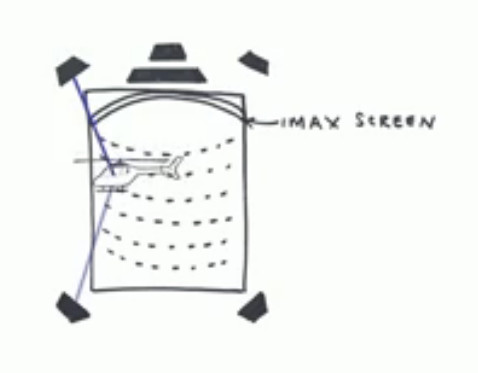Digital Cinema – During a recent visit to IMAX in Mississauga, Ontario, we had a chance to get a demo of IMAX’s new audio solution. The current system is based on six tracks of audio but the new one will deliver 12 tracks. IMAX supplies its own speakers that have an extended frequency response and dynamic range and very powerful amplifiers for distortion-free audio.
IMAX has the ability to control the theatrical environment to be able to deliver a more consistent audio experience and a much bigger “sweet spot”. For example, the company specifies the theater geometry and insulates the walls and ceiling to allow the quietest noises to be heard. The custom designed speakers have a wider dynamic range than conventional theatrical speakers. According to David Ramsahoye, IMAX’s manager of audio technology, the low frequency response goes down to 23 Hz, which gives a deep subwoofer capability – but it has also identified low frequency noises in films that the mastering facilities never heard before (THX systems only go down to 40Hz). The high frequency response is also higher to offer a wider dynamic range in sound reproduction.
Sound is an integral part of the theatrical experience. Did you know that the human brain can actually process audio faster than images? According to IMAX, it takes as little as 50 ms for a person to identify a sound and where it is coming from. It can take 250-500 ms to process a visual image. Interesting.
 Most theaters have 5.1 surround systems. That means L/R front speakers, L/R surround speakers, a central speaker and a subwoofer. In a theater, the left and right surround channel is connected to all of the speakers along the side walls and back wall. That is done to ensure that every row gets the same surround audio. That’s fine, but it does not allow for the movement of sound around the room. For example, a helicopter sound can’t move from front left to back left – it is heard on the left side.
Most theaters have 5.1 surround systems. That means L/R front speakers, L/R surround speakers, a central speaker and a subwoofer. In a theater, the left and right surround channel is connected to all of the speakers along the side walls and back wall. That is done to ensure that every row gets the same surround audio. That’s fine, but it does not allow for the movement of sound around the room. For example, a helicopter sound can’t move from front left to back left – it is heard on the left side.
The Barco Auro 11.1 system uses the speakers in a dual stacked 5.1 system, but processes the sound differently. It creates a second layer of speakers further up the wall of the theater to create two additional layers of sound – a height and overhead layer. This helps to create the effect of sound coming from above you.
The IMAX solution uses dedicated speakers for each track, not banks of speakers. The six-track system features front L/R, back L/R, and two center speakers. Each is driven with separate audio tracks so the helicopter sound now can move from front to back – or around the room in a circle.
 This is possible because the speakers are not omni-directional in output. IMAX uses a technology it calls Proportional Point Source (PPS). Denis Tremblay, one of IMAX’s senior audio designers explained to us that PPS allows the delivery of the same sound level to people close to the speaker or those further away. That translates into an audio sweet spot that covers nearly the entire theater. (The flare rate on the lower portion of the horn speaker is faster than on the upper part to create a reduced sound density for the seats close to the loudspeaker.)
This is possible because the speakers are not omni-directional in output. IMAX uses a technology it calls Proportional Point Source (PPS). Denis Tremblay, one of IMAX’s senior audio designers explained to us that PPS allows the delivery of the same sound level to people close to the speaker or those further away. That translates into an audio sweet spot that covers nearly the entire theater. (The flare rate on the lower portion of the horn speaker is faster than on the upper part to create a reduced sound density for the seats close to the loudspeaker.)
In a 12-track solution, IMAX added two additional side speakers and four ceiling speakers. Then, using phantom imaging techniques, the company is able to create sounds that appear to emanate from anywhere in the room – now including overhead.
The demo we listened to in the mixing room was impressive. Sounds could easily be heard coming from many different directions in a dome of audio, including sounds that moved smoothly about the room.
IMAX helps ensure this consistent audio experience by placing speakers in every theater and measuring the sound on a daily basis. IMAX also maintains a network operation center where the projectors, audio and other theater operational variables are managed 24/7. Corrections can often be made without theater operator input.
The Dolby Atmos solution offers a similar audio experience in that it creates multiple origin points of sound, but how this is achieved uses a very different approach. Dolby and IMAX may start with the same sound objects, but IMAX renders the sound placement and movement into discrete track of sound. Dolby maintains the object trajectory information right to the theater where it is rendered in place to fit the specific speakers and geometry of that theater. That can work very well in some theaters, but some are concerned about the ability to create the same sound experience over thousands of different theater installations.
Barco’s recent purchase of IOSONO may allow the company to offer a similar capability in the future (see our article on Barco’s 20.1 sound approach here). We shall see. – Chris Chinnock

